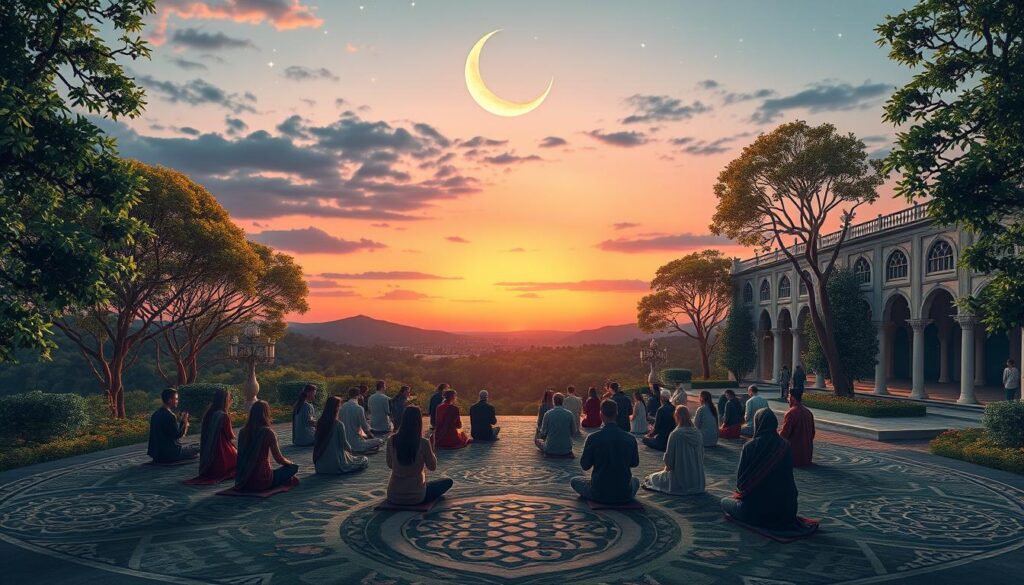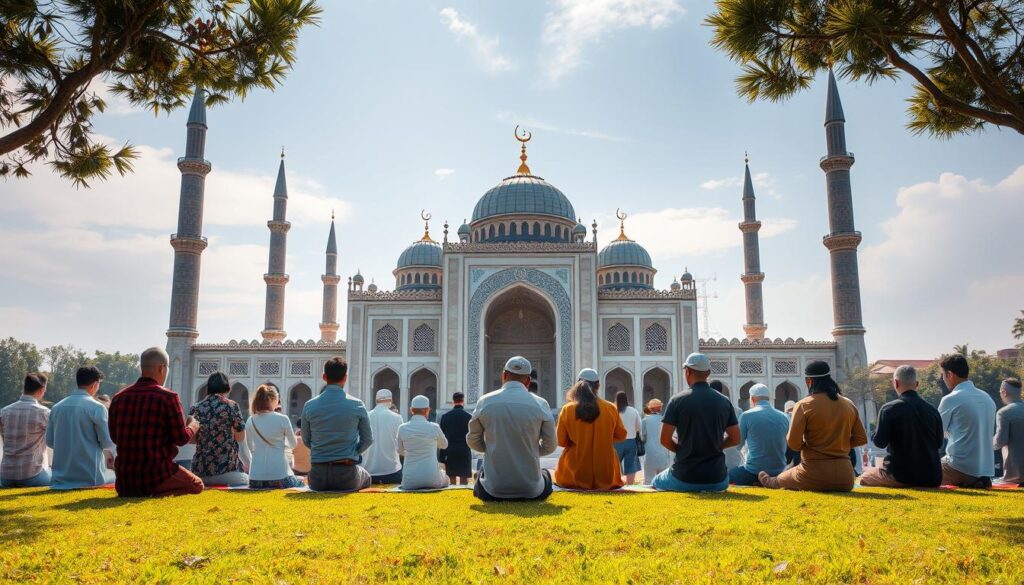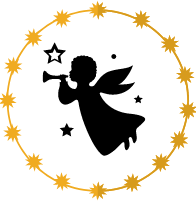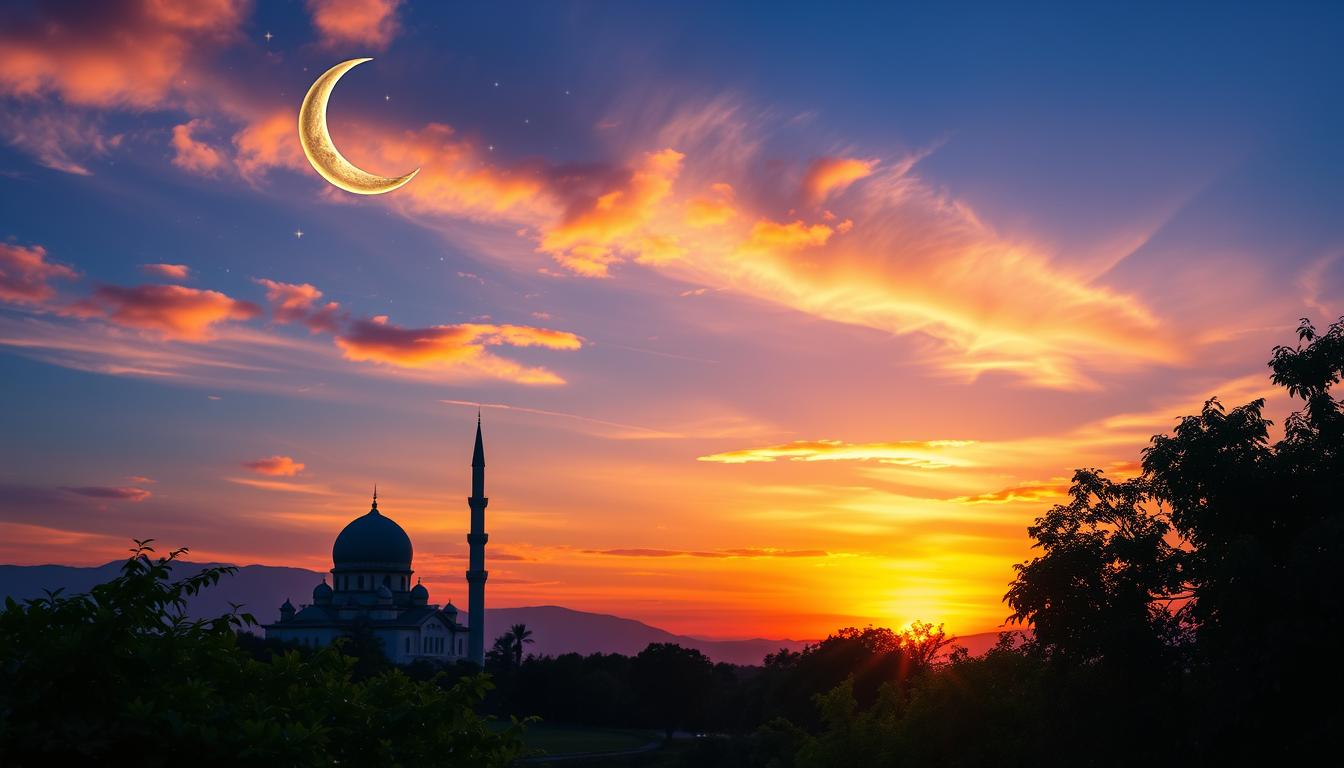The word “Muslim” comes from the Arabic “muslim,” meaning “one who submits” to God. This shows the core of Islam, which is following God’s will. The word first showed up in English around 1615.
Welcome to checkreligion.com
Meaning of Muslim !
At first, it was spelled “Moslem.” Now, we use “Muslim,” which sounds closer to the Arabic. Today, about 1.9 billion people call themselves Muslim. This makes Islam the second-biggest religion, with nearly 25% of the world’s people.
The word “Muslim” also shows the rich diversity of cultures and languages. It’s found in Spanish, French, Japanese, and Chinese, among others. It’s a key word for a big and varied group of people.
Knowing what “Muslim” means is more than just a label. It’s about a wide range of beliefs and actions. These show the personal paths of those who follow this faith.
Key Takeaways
- The term “Muslim” means “one who submits” in Arabic.
- Approximately 1.9 billion Muslims exist globally, making it the second-largest religion.
- The term has evolved in English from “Moslem” to “Muslim.”
- Muslims are found in diverse cultures and languages around the world.
- The word represents a rich tapestry of beliefs and practices.
- About 80% of Muslims are not Arabs, showcasing the religion’s diversity.

Understanding the Definition of Muslim
The word “Muslim” means a lot, coming from a deep history. It used to mean those who follow God’s will. But now, it has grown to include many cultures and beliefs.
Historical Context of the Term
The idea of being a Muslim started with Abraham and Jesus. They showed what it means to follow God. When Prophet Muhammad got his revelations in 570 CE, more people joined.
This shows that being a Muslim has always been about a big, diverse group.
Modern Implications of Being a Muslim
Today, being a Muslim is more than just a religion. With 1.8 billion followers, Islam is the biggest and fastest-growing faith. People from all over the world are Muslims, showing the faith’s wide reach.
In America, about 10 million Muslims live, adding to the country’s mix. This diversity leads to many ways of seeing faith.
Talking to Muslims, I see how different their stories are. The word “halal” is not just about food. It’s about living right every day. But, Muslims face challenges like being treated unfairly.
Despite these, believing in Allah and following the Five Pillars of Islam is key to being a Muslim today.
Exploring the Meaning of Muslim
Looking into what it means to be Muslim is very personal. It’s shaped by our own stories and where we come from. Even though we share some beliefs, how we see Islam can be very different. This variety makes our identities richer and more interesting.
Personal Interpretations
How we see being Muslim is shaped by many things. Our culture, life experiences, and the people around us play big roles. For example, some might stress the importance of praying every day and fasting during Ramadan. Others might focus more on helping others and being part of a community.
These differences show that being Muslim is more than just following rules. It’s about how we live our lives and what we value.
Impact on Identity
Our faith is closely tied to our race, ethnicity, and culture. For over 1 billion Muslims worldwide, their faith is deeply connected to their traditions. In places like Detroit, Michigan, the Nation of Islam shows how faith and culture can blend together.
For many, being Muslim is not just about their faith. It’s also a big part of their cultural story. This creates a complex relationship with the world around them.

| Aspect | Personal Interpretation | Impact on Identity |
|---|---|---|
| Cultural Practices | Varying emphasis on rituals like prayer and Ramadan | Integration into community identity |
| Community Influence | Different beliefs shaped by local customs and practices | Connection to heritage and family |
| Social Issues | Focus on justice and activism varies | Role in combating stereotypes and alienation |
Who is a Muslim?
Learning about Muslims means looking at the demographics of Muslims worldwide. They are about 1.9 billion strong, making up 25% of the world’s people. You can find Muslims on every continent, showing a mix of cultures and beliefs.
The diversity among Muslims comes from many places. This includes where they live, their politics, and their faith. These things shape who they are.
Demographics of Muslims Worldwide
Muslims live in many parts of the world. In Africa, about 45% of people are Muslim. In Asia and Oceania, it’s 25%. Europe has 6%, and the Americas have 1%.
Looking closer at the numbers shows us:
| Region | Estimated Muslim Percentage |
|---|---|
| Middle East–North Africa | 91% |
| Central Asia | 90% |
| Caucasus | 65% |
| Southeast Asia | 42% |
| South Asia | 32% |
| Sub-Saharan Africa | 42% |
These numbers show how Muslims are spread out in the world.

Conversion to Islam
Understanding Muslims also means looking at conversion to Islam. To become a Muslim, one must say the Shahada. This is a promise to believe in one God and Muhammad as his prophet.
People become Muslim in many ways. Some find Islam through personal experiences, friends, or even meeting people from other faiths. Islam’s teachings and sense of community attract people from all walks of life.
Key Beliefs in the Islamic Faith
Muslim beliefs are about six main principles. These principles guide Muslims every day. They help Muslims connect with each other and their faith.
Core Principles of Islam
The six main beliefs are at the heart of Islam. Every Muslim must believe in these:
- The Oneness of God (Tawhid)
- The Prophethood of Muhammad
- The Angels of God
- The Divine Books (including the Qur’an)
- The Day of Judgment
- The Divine Decree (Qadar)
Muslims see these beliefs as more than rules. They are like lights that guide to spiritual happiness. Saying “There is no god but Allah, and Muhammad is His messenger” is a key step in joining the faith.
The Role of the Quran
The Quran is very important to Muslims. It is a sacred book that guides on life’s big questions. It tells stories of prophets like Adam and Abraham.
The Quran also talks about being accountable for our actions. It teaches that we are born without sin but become responsible when we grow up. Muslims follow Five Pillars of Islam, like praying and fasting, to stay connected to their faith.
In summary, knowing the Islamic beliefs is key to understanding the Muslim world. With over a billion followers, these beliefs unite and celebrate the faith’s diversity.
Muslim Practices: Daily Life and Rituals
Muslims live their daily lives based on their faith. The five pillars of Islam guide them. These pillars help them live in harmony with their beliefs.
Five Pillars of Islam
The five pillars are the heart of Muslim practices. They shape the daily lives of believers. These pillars are:
- Shahada: Saying there is no god but Allah, and Muhammad is His messenger.
- Salah: Praying five times a day to stay close to God.
- Zakat: Giving 2.5% of savings to help others, showing kindness.
- Sawm: Fasting in Ramadan to feel closer to God.
- Hajj: Going to Mecca once in a lifetime for those who can.
Prayer and Worship
Prayer is key for Muslims, with five daily prayers. These prayers remind them of their faith. Before praying, they clean themselves.
Every Friday, Muslims come together for special prayers. They listen to a sermon. This shows their unity and faith.
By following these practices, Muslims balance their spiritual and everyday lives. They make sure their actions match their beliefs.
Exploring Muslim Culture
Muslim culture is rich and diverse. It spans over 1.5 billion people. This diversity shows in art and literature, blending faith with creativity.
Art and Literature in Islam
Art and literature in Islam share deep spiritual messages. They show the creativity of Muslim communities. For example, calligraphy and architecture are beautiful and express faith.
Intricate tile work and decorative calligraphy in mosques and manuscripts are key. They highlight the importance of the written word. Poetry and literature by Muslim authors also add to world literature, touching on love, spirituality, and human experiences.
Cultural Diversity Among Muslims
Muslims have diverse practices and traditions. Food, clothing, and music reflect local customs and history. This variety adds a unique flavor to Muslim cultures, celebrating their shared faith and unique traditions.
| Region | Art Style | Literary Tradition | Popular Cuisine |
|---|---|---|---|
| The Middle East | Geometric designs and tile work | Arabic poetry and prose | Hummus, falafel |
| South Asia | Mughal architecture and miniatures | Urdu poetry and storytelling | Biryani, naan |
| North Africa | Berber textiles and woodwork | Arabic folklore and fables | Couscous, tagine |
| Southeast Asia | Silk batik and shadow puppetry | Malay literature and Hikayat | Nasi goreng, rendang |
This diverse Muslim culture shows a shared faith and great variety. It proves Islam is not just one culture. The art and literature of Muslims enrich our global heritage.
Traditions and Customs in Muslim Communities
Muslim traditions show a rich mix of diversity and unity. These customs are shared for generations. They highlight community values and spiritual importance.
Among the most celebrated are the significant Muslim festivals. These festivals bring families and friends together in joy.
Festivals and Celebrations
The Islamic calendar is filled with Muslim festivals that are very important. Eid al-Fitr is a big celebration at the end of Ramadan. It starts with prayers in mosques and then festive gatherings and meals called Iftaar.
Families enjoy special dishes together. These dishes vary by region.
Eid al-Adha is another key festival. It remembers Ibrahim’s willingness to sacrifice his son for God. The celebration includes animal sacrifice, with meat given to relatives and the poor.
This shows the importance of charity in Muslim traditions.
Family and Social Structure
Family is very important in Muslim communities. The family structure is often hierarchical. There is a big focus on respect and duty to elders.
Family gatherings happen often during religious times. These gatherings strengthen family bonds and show collective responsibility. They are not just celebrations but also expressions of faith and love.
Muslim Traditions in Contemporary Society
Muslim traditions today are a mix of old and new. Global changes affect how Muslims live their faith. This leads to new ways of practicing Islam that fit today’s world.
Young Muslims mix old traditions with new ways. They blend their culture with today’s life. This makes their faith practices unique and meaningful.
Adaptations and Changes
Many Muslims today mix old and new customs. They adjust their faith to fit today’s world. This helps them stay true to their culture while facing new challenges.
For example, families used to be bigger. Now, many live in smaller families. This can make people feel lonely.
- Traditions adapted for modern life: Young Muslims may incorporate modern styles into traditional attire while maintaining core significance.
- Changing family structures: Increasingly, couples are marrying later in life despite traditional teachings encouraging earlier marriages.
- Interfaith relations: While intermarriage is on the decline for genetic health reasons, dialogue between different faiths continues to be important.
The Influence of Globalization on Muslim Practices
Globalization changes how Muslims practice their faith. A global survey by the Pew Research Center shows big differences in views on sharia law. For example, in South Asia, 84% support it, but in Central Asia, only 12% do.
| Region | Support for Sharia Law (%) |
|---|---|
| South Asia | 84 |
| Southeast Asia | 77 |
| Middle East and North Africa | 74 |
| Sub-Saharan Africa | 64 |
| Southern and Eastern Europe | 18 |
| Central Asia | 12 |
Muslim communities worldwide are changing with culture. The talk about family law is strong. Many want religious judges to help with family issues.
These changes show how Muslims balance old traditions with new life. They want to keep their roots while living in today’s world.
Conclusion
Being a Muslim is more than just a belief. It’s a rich mix of faith, practices, and culture. We learn that Muslims believe in one God and value all prophets equally. The Qur’an guides them to live right and find peace.
Muslims come from all over the world, making up a big community. They live in many places, showing Islam’s global reach. Their stories show how faith and culture shape who they are today.
Learning about Islam shows us its beauty and the chance for unity. It teaches us to care for each other, no matter our differences. I hope this helps us see Muslims in a new light and understand their faith better.
FAQ
What does the term “Muslim” mean?
“Muslim” comes from Arabic, meaning “one who submits” to God. It shows Islam’s main idea: obeying and following God’s will.
How is the identity of a Muslim shaped?
A Muslim’s identity comes from their faith, culture, and life experiences. This mix leads to many ways of showing faith in different groups.
How many Muslims are there in the world today?
About 1.9 billion Muslims live worldwide. This makes Islam a big religion, with about 25% of the world’s people.
What are the core beliefs of Muslims?
Muslims believe in one God, Muhammad as a prophet, and the Quran as God’s word. These beliefs guide their spiritual and moral choices.
What are the Five Pillars of Islam?
The Five Pillars are key acts of faith for Muslims. They include declaring faith, praying, giving to charity, fasting, and making a pilgrimage to Mecca.
How do Muslims celebrate major festivals?
Festivals like Eid al-Fitr and Eid al-Adha are big celebrations. Muslims come together for prayers, meals, and fun, showing their unity and faith.
How do cultural practices influence Muslim traditions?
Muslim culture is very diverse. Local customs shape things like food, clothes, and music. This shows Islam is not just one culture.
What is the significance of the Quran in Islam?
The Quran is more than a prayer book. It’s a guide for life, affecting how Muslims live, think, and act together.
How do modern challenges affect Muslim practices?
Changes like globalization and cultural mixing change how Muslims practice. Younger people especially find new ways to follow their faith.
What does it mean to convert to Islam?
Becoming a Muslim means saying the Shahada, a declaration of faith. It can happen in many ways, showing Islam’s appeal to many cultures.

